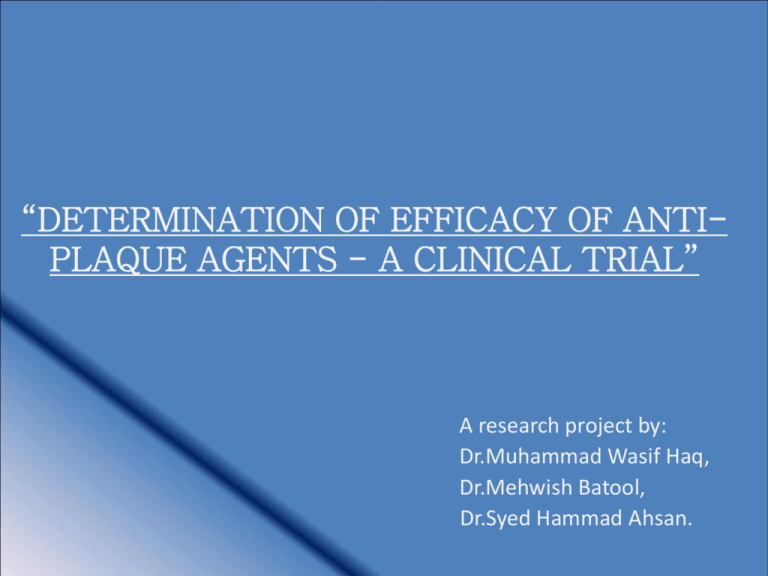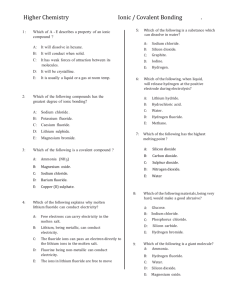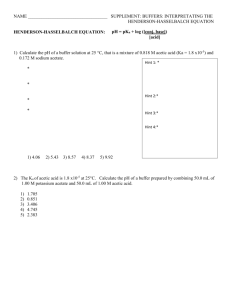determination of efficacy of anti-plaque agents - a
advertisement

“DETERMINATION OF EFFICACY OF ANTIPLAQUE AGENTS - A CLINICAL TRIAL” A research project by: Dr.Muhammad Wasif Haq, Dr.Mehwish Batool, Dr.Syed Hammad Ahsan. Introduction • Plaque control & prevention still stand as a challenge for modern day dentistry. • Adequate plaque control related to optimal oral health & reduction in pathologies e.g. Gingivitis, Periodontitis, Caries and Periimplantitis. • Tooth brushing in conjunction to mouthwashes reported to impart superior plaque control. Introduction • • • • • • Antiplaque agents: The common antiplaque agents used are: Chlorhexidine. Fluoride. Chlorhexidine + Fluoride. Cetylpyridinium Chloride + Fluoride. Introduction • Chlorhexidine: • Cationic, bacteriostatic & bactericidal agent. • Inhibits bacterial Glucosyltransferase, causes cytoplasmic precipitation & bacterial cell wall disruption. • Inhibitor of Matrix metalloproteinases, proinflammatory cytokines, interleukins & salivary Cathepsin C. Introduction • Fluoride: • Anionic, bacteriostatic & bactericidal agent. • Remineralizes tooth structure, formation of acid resistant and larger Fluoroapatite crystals. • Inhibits Glucosyltransferase, Enolase, Glucose uptake & utilization. • Inhibits salivary Cathepsin C. Introduction • Cetylpyridinium Chloride: • Bactericidal, quartenary ammonium compound. • Inhibits metabolic pathways, denatures bacterial proteins & damages cell wall. • Bioaccumulation in dental plaque. Introduction • Matter of debate: • Inconclusive results on combination of Chlorhexidine with Fluoride. • Some report synergistic interaction while others report negative interaction. • Very few studies have evaluated the combination of Cetylpyridinium Chloride with Fluoride. Aims & Objectives • Primary aim to determine efficacy of antiplaque agents: • Chlorhexidine. • Sodium Monofluorophosphate. • Chlorhexidine + Sodium Monofluorophospahte. • Cetylpyridinium Chloride + Sodium Fluoride. Materials & Methods • A 5 day study conducted at L.C.M.D. Karachi. • Informed consent was taken. • Random allocation into 4 test groups & 1 control group ( 6 subjects/group). • Plaque levels estimated prior to & at the completion of the study using Turesky et al modification of Quigley Hein plaque index. Materials & Methods • Inclusion criteria: 18-50 years. Complete dentition till 2nd Molar in all the four quadrants. Exclusion criteria: Any teeth with active dental caries or signs of periodontal involvement . Subjects with any systemic disease or using medication. Undergoing orthodontic treatment. Subjects wearing prosthetic appliances. Materials & Methods • Participants instructed to: • Brush teeth1 time (1 minute)with Fluoride toothpaste. • Mouthwash (5 ml with 10 ml water) 2 times (30 Seconds). • Control group brushed teeth with water. • Follow routine dietary habits. • One way ANOVA & Bonferroni test for Multiple Comparisions applied. Materials & Methods Name of group Number of subjects Active ingredients Group 1 6 0.2% Chlorhexidine gluconate. Group 2 6 0.05% Sodium Monofluorophosphate Group 3 6 0.12% Chlorhexidine gluconate & 0.05% Sodium Fluoride. Group 4 6 0.05% Cetylpyridinium Chloride & 0.05% Sodium Fluoride. Control 6 Water. Results Group Pre-test Post-test Reduction Significance Group 1 11.89 11.0 0.89 p=0.032 Group 2 11.22 10.59 0.27 p=0.146 Group 3 13.37 13.41 -0.04 p=0.271 Group 4 13.36 12.34 1.02 p=0.023 Control 11.61 14.23 2.62 - Discussion • Compared to control group, all study groups decreased plaque levels. • Statistically significant difference only in Chlorhexidine (group 1) & Cetylpyridinium Chloride + Fluoride(group 4)compared to control group (p < 0.05). • Only Chlorhexidine & Fluoride combination did not decrease plaque levels. Discussion Plaque inhibitory action • Group 4 (Cetylpyridinium Chloride & Sodium Fluoride) • Group 1 (Chlorhexidine) • Group 2 (Sodium Monofluorophosphate) • Group 3 (Chlorhexidine and Sodium Flouride)) • Control Group (Water) Discussion • Cetylpyridinium Chloride + Fluoride seems to offer best anti plaque activity,more effective than Chlorhexidine or Chlorhexidine with Fluoride. • Increasing Fluoride concentration did not offer increased antiplaque effect. • Synergistic effect reported for Chlorhexidine with Fluoride not observed in this study. Discussion • New Research Challenges: • Few or no side effects. • Chlorhexidine : Stains, taste alteration, supragingival calculus,cytotoxic to odontoblasts, fibroblasts & osteoblasts. • Sodium Fluoride: Cytotoxicity to fibroblasts, oral mucosal cells & odnotoblasts. • Cetylpyridinium Chloride: Staining. • Toothpaste compatible mouthwashes. Limitations • Small sample size. • Inability to eliminate tooth brushing. • Possibility of lack of compliance & nonuniformity of diet. • Alternatively experiments utilizing antimicrobial isolates on teeth of laboratory animals & assessing inhibitory effect of antiplaque agents on microbial colonies could provide better results. Conclusion • Antiplauque effect : Cetylpyridinium Chloride + Sodium Fluoride> Chlorhexidine> Sodium Monofluorophosphate. • Chlorhexidine + Sodium Fluoride combination did not reduce plaque levels. • Increasing Fluoride concentration did not improve antiplaque effect. Special Thanks • Our courteous thanks to: • Teachers: Dr. Naheed Najmi (L.C.M.D., Karachi). Dr.Asif Hussain(L.C.M.D., Karachi). Dr.Nadeem Chand (L.C.M.D., Karachi). Team Members: Dr.Mehwish Batool. Dr.Syed Hammad Ahsan. • All the participants of the study. References • de Freitas CS, Diniz HF, Gomes JB, Sinisterra RD, Cortés ME.Evaluation of the substantivity of chlorhexidine in association with sodium fluoride in vitro. Pesqui Odontol Bras. 2003 Jan-Mar;17(1):78-81 • Feres M, Gursky LC, Faveri M, Tsuzuki CO, Figueiredo LC.Clinical and microbiological benefits of strict supragingival plaque control as part of the active phase of periodontal therapy. J Clin Periodontol. 2009 Oct;36(10):857-67 • Tyldesley. Oral Medicine. In: Tyldesley. Therapy.5th edition. Karachi: Oxford University press, 2007, pp25 • A. D. Russell. Chlorhexidine: Antibacterial Action and Bacterial Resistance. Infection. 1986 Sep-Oct; 14(5):212-5 • Mitchell DA, Mitchell L. Oxford handbook of clinical dentistry.In David A.Mitchell, Laura Mitchell:Periodontology. 4th ed. Karachi: Oxford University Press, 2005:pp 202 References • Guha-Chowdhury N, Clark AG, Sissons CH.Inhibition of purified enolases from oral bacteria by fluoride.Oral Microbiol Immunol. 1997 Apr;12(2):91-7. • Shani S, Friedman M, Steinberg D.The anticariogenic effect of amine fluorides on Streptococcus sobrinus and glucosyltransferase in biofilms.Caries Res. 2000 MayJun;34(3):260-7. • Sturevant’s. Art and science of Operative Dentistry. In: Theodore M. Roberson, Thomas F. Lundeen. Cariology : The lesion, Etiology, prevention and control. 4th edition. Philadelphia : Mosby, 2002, pp 110-3 • Dabrowska E, Letko M, Roszkowska-Jakimiec W, Letko R, Jamiolkowski J.Effect of fluoride preparations on the activity of human salivary cathepsin C.Rocz Akad Med Bialymst. 2005;50 Suppl 1:160-2. HUMBLE THANKS






